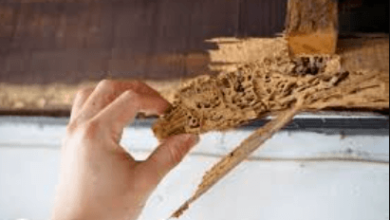
How To Spot Hidden Mold In Your Home
Do you suspect there might be hidden mold growing in your home? Mold can cause serious health issues if it’s not dealt with quickly and properly.
Spotting hidden mold can be a tricky task, but with the right steps and tools, you can get rid of it for good. In this article, we’ll show you how to:
– Identify signs of hidden mold
– Inspect areas that are prone to moisture buildup
– Test for mold
– Remove the source of moisture
– Clean up visible mold
– Use a professional cleaning service.
With our help, you’ll have your home free from unwanted mold in no time!
Identify the Signs of Hidden Mold
Be alert to any tell-tale signs of mold infestation in order to safeguard the health of those around you.
Signs of hidden mold can be difficult to detect, but it’s important to stay vigilant and keep an eye out for any potential warning signs.
Reviewing air quality is a good place to start. If an area smells musty or faintly like mildew, that could indicate the presence of hidden mold.
Check ventilation and other areas with poor airflow such as crawl spaces and attics, as these are particularly prone to moisture build up which can lead to mold growth.
Look for watermarks on walls, carpets or furniture that could signal a leak or excessive humidity in the home.
Lastly, examine areas where there have been previous flooding incidents as this may lead to long-term mold problems even after all standing water has been removed.
With careful observation and inspection, you can take steps now to protect your family from unseen dangers posed by mold infestation.
Inspect Areas of High Humidity
Check moisture-prone areas like bathrooms, laundry rooms, and basements for any signs of discoloration or musty odors. These are indications that there may be hidden mold present.
It’s important to check vents and monitor humidity levels in all these spaces, as high humidity can lead to mold growth.
Additionally, keep an eye out for any condensation on windows or walls as this is a sign of excess moisture buildup in the air.
Look inside cabinets and corners for dark patches that might indicate water damage from previous flooding or leaks.
Pay close attention to surfaces around pipes, drains, showers, and tubs as these are common places where mold can form due to the moist environment.
If you notice any of these signs, it’s best to take action right away by testing for mold.
Test for Mold
Don’t let mold go undetected; take action to test for it now! Professional mold testing services can be found online and are quite affordable. These services will usually include a kit that you can use to take air samples from around your home.
The results of the tests will tell you if any traces of mold are present in your home’s air quality. Taking this step is an important part of determining the source and amount of any hidden mold in your home, so you’ll know how best to address it.
Using DIY test kits is another option when testing for hidden mold in your home. You’ll typically find these at local hardware stores or online retailers. In most cases, the instructions will guide you through collecting a sample from suspected affected areas and sending it off for analysis.
The results should indicate whether or not there is an issue with hidden mold in your home, which can then be addressed accordingly. Moving on from here, the next step is to identify and remove the source of moisture that has caused the problem in the first place.
Remove the Source of Moisture
To prevent mold from becoming a problem in the future, it’s important to investigate and remove the source of moisture that may have caused it.
Start by checking for ventilation issues that could be allowing moisture into your home. Make sure there aren’t any blocked vents or air intakes, such as those around radiators or window frames.
Additionally, take steps to reduce humidity levels in your home. This can be done by using dehumidifiers, limiting steam creation (such as boiling water on the stove or running hot showers), and cleaning surfaces regularly with non-abrasive products.
These steps should be taken to identify and address any potential sources of moisture that could lead to mold growth in your home:
– Check ventilation issues
– Use dehumidifiers
– Limit steam production
– Clean surfaces regularly
By taking these precautions, you’ll ensure that the chances of any hidden mold returning are minimized, and you can maintain a healthy indoor environment for yourself and family members.
Clean Up Visible Mold
Once you’ve identified potential sources of moisture, it’s time to tackle any visible mold in your abode.
Proper ventilation and damp proofing can help prevent visible mold from reappearing, but cleaning up visible mold is a necessity if you want to keep your home healthy and free of contaminants.
You’ll need the right tools for the job: rubber gloves, protective eyewear, an N-95 or P-100 respirator mask, soap and water or a cleaner specifically designed for removing mold.
Cleaning involves scrubbing away at surfaces with a brush and detergent solution, then wiping off the excess liquid with a cloth or sponge.
It’s important to make sure that all affected areas are thoroughly cleaned – including inside wall cavities where mold may be growing – before allowing them to dry completely.
Use a Professional Cleaning Service
If your home is infested with mold, consider enlisting the help of a professional cleaning service to tackle it – they have the expertise and tools to rid your abode of the pesky fungi and restore it to its former glory.
A professional cleaning service can provide you with:
1. Professional advice on how best to address any mold issues in your home
2. A comprehensive inspection of your property for signs of hidden mold or moisture problems
3. The right equipment and products for safe removal and remediation of mold colonies
4. Expertise in restoring areas affected by mold growth back to their original condition
Engaging a professional cleaning service not only gives you access to experienced technicians who understand what’s required to safely remove and prevent future outbreaks, but also provides peace of mind that the job is done correctly and thoroughly.
They can identify potential sources for water intrusion, advise on preventative measures, as well as offer recommendations on ways to reduce moisture levels in higher risk areas like kitchens or bathrooms.
Conclusion
You’ve learned how to spotting hidden mold in your home. Now it’s time to take action!
Inspect for areas of high humidity, and test for mold if you suspect it may be present. Don’t forget to remove the source of moisture and clean up any visible mold.
Finally, if you’re still concerned that there might be hidden mold lurking somewhere, it’s best to call a professional cleaning service – they’ll get rid of it in no time flat.
Take the steps necessary to protect your health and safety – don’t let hidden mold ruin your peace of mind! As the old saying goes, “An ounce of prevention is worth a pound of cure.”




